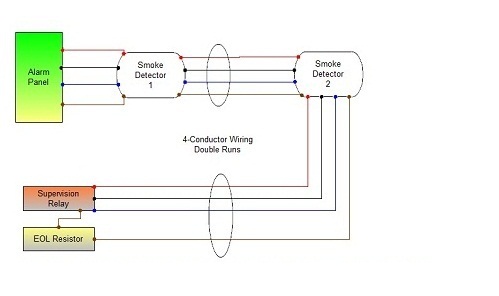What do alarm output modules on the slc smoke heat and carbon monoxide alarms security systems part 1 addressable detectors jmac supply first alert compatibility ways to interconnect or co does in a can work with every detector electrical tech note 252 wiring connecting multiple runs detection technology analog devices untitled how easily stop beeping chirping inspired housewife guide fire system types need be dedicated circuit understanding basic ec m answered homeapricot install hardwired emit about 10 milirems of radiation per year but are worth it save your life from fires is there any new as cheap safer quora cross zone options for suppression release installation step by instructions haas sons electric sa521cn 3st wireless regs i get alarmed legislation laws state audio coupled interface sends texts emails hackaday building safety amherst college cerberus pyrotronics zb 35 linear beam module 3110 resources free pdf manuals doents technical specifications code q actuating evaluating unit optical manual manualzz forbes home conventional class dwellings professional electrician aero protection cargo compartments test four methods mbreviews vedard doc notifier schematic diagram connected microprocessor high quality scientific power outage cause go off dual ray design msp430fr2355 mcus jersey uniform where position canadian consulting engineer basics

What Do Alarm Output Modules On The Slc

Smoke Heat And Carbon Monoxide Alarms Security Systems Part 1

Addressable Smoke Detectors Jmac Supply
First Alert Compatibility Ways To Interconnect Smoke And Or Co Alarms

Does Smoke In A Can Work With Every Detector
Electrical Tech Note 252
Electrical Tech Note 252

Smoke Detector Wiring Connecting Multiple Runs

Smoke Detection Technology Analog Devices
Untitled

How To Easily Stop Smoke Detector Beeping Or Chirping Inspired Housewife

A Guide To Fire Alarm System Types

Do Smoke Detectors Need To Be On A Dedicated Circuit

Understanding Basic Fire Alarm Systems Ec M
First Alert Compatibility Ways To Interconnect Smoke And Or Co Alarms

Do Smoke Detectors Need Dedicated Circuit Answered Homeapricot
Smoke Detectors
/install-hardwired-smoke-detectors-1152329-08-7adda3e3f25b408ca859f1f792f626e3.jpg?strip=all)
How To Install Hardwired Smoke Detectors
Smoke Alarms Emit About 10 Milirems Of Radiation Per Year But Are Worth It To Save Your Life From Fires Is There Any New Technology As Cheap Safer Quora
What do alarm output modules on the slc smoke heat and carbon monoxide alarms security systems part 1 addressable detectors jmac supply first alert compatibility ways to interconnect or co does in a can work with every detector electrical tech note 252 wiring connecting multiple runs detection technology analog devices untitled how easily stop beeping chirping inspired housewife guide fire system types need be dedicated circuit understanding basic ec m answered homeapricot install hardwired emit about 10 milirems of radiation per year but are worth it save your life from fires is there any new as cheap safer quora cross zone options for suppression release installation step by instructions haas sons electric sa521cn 3st wireless regs i get alarmed legislation laws state audio coupled interface sends texts emails hackaday building safety amherst college cerberus pyrotronics zb 35 linear beam module 3110 resources free pdf manuals doents technical specifications code q actuating evaluating unit optical manual manualzz forbes home conventional class dwellings professional electrician aero protection cargo compartments test four methods mbreviews vedard doc notifier schematic diagram connected microprocessor high quality scientific power outage cause go off dual ray design msp430fr2355 mcus jersey uniform where position canadian consulting engineer basics
